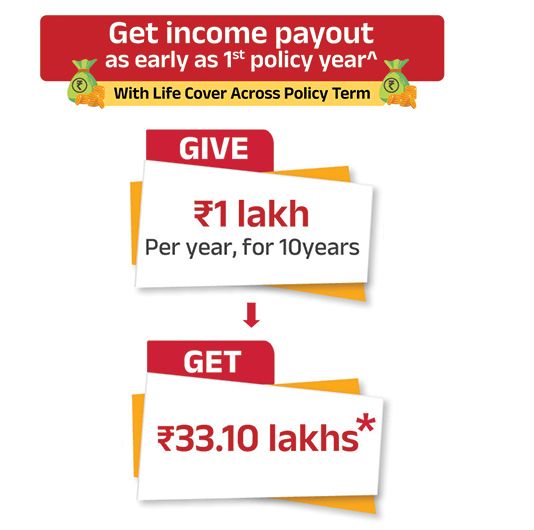Introduction
For most budding investors, a short-term investment option seems more practical and doable. It is not just that the goal/ expense is upcoming, but most people see a period of 5 years or less to be a safer option. Investing for a longer period of 10 or 20 years might be a little difficult for someone who has just begun their investment journey. If you are looking to save money that is accessible enough for your not-so-distant future, a 5-year investment might be a great option. These plans not just minimise the risk but also prove to be tax-saving schemes as well.
Types of Investment Plans for 5 Years
If you are looking for investment options for a period of 5 years or less, consider the following:
01: ULIPs
Definition
ULIP stands for Unit Linked Insurance Plan. It is a multi-faceted product that offers life insurance with the benefits of market-related investment. You make a premium payment toward the ULIP. A part of this premium is kept for your life coverage, while the remaining is invested in the market in equity and debt funds. You stay financially secured while enjoying the benefit of liquidity.
Features and Benefits
- It helps you invest money in market-related products as per your risk appetite.
- A long-term saving option that offers dual benefits.
- You can save on taxes with these tax-saving schemes as they come under Section 80C and 10(10D).
- You have the freedom to switch between your investment funds.
- Most ULIPs come with a 5-year lock-in period.
Return Rate
Analysing return rates for ULIPs may not be entirely possible as the recurring commitment of premium often creates an element of indiscipline. The returns also depend on the tenure of investment. While 3-year returns can range between 6.6% to 16.81%, 5-year returns can go from 9.21% to 24.43% as well*.
Eligibility
Most companies have easy eligibility criteria for purchasing ULIPs. The entry age can range between 7 to 70 years for Indian residents.
Risk level
ULIPS come with a certain risk factor that you may cater for as an investor, but because you have the freedom to choose and switch between funds, you can invest in ones that suit your portfolio - Debt funds, Equity Funds or Balanced Funds.
Example
ABSLI Wealth Aspire Plan
- Comes with 4 investment options
- Allows partial withdrawal
- Offers guaranteed1 additions
ABSLI Wealth Assure Plus
16 funds and 4 investment options
Allows premier waiver
Can opt for riders
How to Invest in ULIPs?
- Do market research to shortlist the best-suited options
- Understand the features of each and then opt for one
- Get in touch with the officials and enquire about the product's details
- Make the purchase when fully satisfied
02: Savings Account Fixed Deposit
Definition
A Savings Account FD is one of the safest ways to grow your money. It grows at a fixed interest rate for a fixed tenure. You may choose the tenure. There are several banks and NBFCs that offer the facility of a Fixed Deposit.
Features and Benefits
- Get assured returns without any fluctuations
- Negligible to no risk involved
- You can renew your FD after its maturity
- The rate of interest is fixed for the fixed tenure
- Senior citizens get higher interest rates than others
Return Rate
The return rate on Fixed Deposits depends on different factors like the tenure chosen for the FD and the amount of investment. The rate may also differ from institution to institution offering the FD plans. You can use digital calculators offered by your preferred bank/ NBFC and get an idea of the return rate that you will be enjoying.
Eligibility
Any individual, company, NRI, joint investors, society, firms, etc. can open an FD account. People above the age of 18 years can open an FD account in their preferred bank or NBFC. Apart from the adults, the minors are also eligible for opening an FD under the guidance of a guardian.
Risk level
A fixed deposit is considered to be one of the safest investment options. It is not affected by market fluctuations and provides assured returns. This is the reason it is considered to be a risk-free investment option.
How to Invest in Savings Account Fixed Deposit?
- Check the options available in the market
- Shortlist the most suitable FD options for you
- Read the benefits, features, tenure, returns, etc.
- Check pre-withdrawal charges
- Choose your ideal one and apply either through the website of the provider or by visiting their branch
03: 5 years NSC
Definition
NSC, or the National Saving Certificate, is a government-initiated scheme that acts as a fixed-income and tax-saving scheme. An affordable and low-risk investment, it can be purchased in the name of a minor as well.
Features and Benefits
- There is no limit to how much you can invest in an NSC. However, you can save only up to ₹ 1.5 lakhs under Section 80C in your tax returns
- Invest as low as ₹ 1,000
- You can enjoy guaranteed1 interest and are completely risk-free
- Though they are not inflation-beating, they are definitely regarded to be safe and assured long-term investment
- You can use your NSC as a loan collateral
Return Rate
The return rate is currently at 6.8% pa.
Eligibility
Open to all Indian residents
Risk level
National Saving Certificate is a fixed-benefit government scheme and comes with minimal risk.
How to Invest in NSC?
Currently, NSC cannot be purchased online. You need to visit a post office and fill in the NSC Application Form. Attach the documents required to make the payment. Once the application is processed, you will receive an acknowledgement of the same.
04: Post Office Time Deposit
Definition
The Post Office Time Deposit schemes are investment tools introduced by the Indian post. Individuals from anywhere in the nation and of any age can apply to these deposit schemes. The aim is to make investment tools accessible to rural and remote parts of India, as the people from such areas have limited resources and facilities.
Features and Benefits
- Minimum deposit criteria, as less as ₹1,000
- This is a tax-saving scheme that allows exemption benefits on the received interest under the section 80C
- Flexible lock-in period, choose a lock-in period of your choice
- You can also withdraw your money when you need it the most
- Receive interest payment in cash or cheque
Return Rate
The current return rate of the Indian post-investment schemes varies from 6.9% to 7.7%. It depends on how much you have invested. You can invest with a minimum of ₹1,000 and a maximum of ₹1,50,000.
Eligibility
Any Indian citizen above the age of 10 can apply for Indian post time deposit schemes. For infants or younger children, dependents and guardians can invest on their behalf.
Risk level
Investing in Indian post-investment schemes involves less to no risk as the plans are backed by the government and have a fixed return.
How to Invest in Post Office Time Deposit?
- Sign up at the Indian Post official website
- Under the General services option, click on "Service Request"
- Request a "New Service", fill in all the asked details carefully
- Make the initial contribution of a minimum of ₹ 1000 to get started with an investment scheme.
You can also apply for these schemes by visiting your nearest post office. Ensure you carry all the necessary documents for KYC and your passport size photographs.
05: Liquid Funds
Definition
Liquid Funds are a type of mutual fund with maturity within 91 days. These funds are debt instruments which include investment in government securities, treasury bills and commercial papers. Liquid funds are short-termed interest yielding, low-risk debt instruments.
Features and Benefits
- Come with no entry or exit fee
- No lock-in period
- Instant withdrawal facility
- Low-risk investment
- Reasonable returns
- Tax exemption benefits
Return Rate
The ROI from liquid funds in India is 8 per cent on average, which is considered far better than the returns of other saving accounts.
Eligibility
Anyone with some money looking for short term and low-risk investment options can invest in Liquid Funds.
Risk level
The risk involved in investing in liquid funds is minimum. They are not entirely risk-free and subject to interest rate change risk and credit risk.
How to Invest in Liquid Funds?
You can invest in liquid funds from any investment portal of your choice. Aditya Birla Capitals is one such platform from which you can get good investment options.
06: Arbitrage Funds
Definition
An arbitrage fund is primarily a type of mutual fund. Under arbitrage funds, a fund manager buys and sells equities at the same time. Unlike other equities, which are purchased and wait to grow until sold, arbitrage equity is dealt with immediately. The difference in the purchase and selling price is the arbitrage fund. As these are small amounts, several arbitrage trades are made in one day to earn evident profit.
Features and Benefits
- The equities are purchased and sold at the same time without waiting
- An arbitrage trade is done when there is a possibility of making a profit instantly
- These are the hybrid funds and are subject to market fluctuations
Return Rate
The return rate is average under the arbitrage funds because it is purchased at one market and simultaneously sold at another market. An experience of 5 years and above in arbitrage begins to yield better returns.
Eligibility
People above the age of 18 years can begin investing in mutual funds like arbitrage funds.
Risk level
It is with little to no risk level linked with arbitrage trades as it is quite a short-term trade. Most people who want no risk go for arbitrage trade.
How to Invest in Arbitrage Fund?
- Visit the website of your preferred brand
- Select the mutual fund investment option
- Login with your account
- Choose from the options available under the arbitrage fund
- Start investing and earning
07: Savings Plan – ABSLI Fixed Maturity Plan
Definition
The ABSLI Fixed Maturity Plan is a non-participating endowment plan that is here to give you guaranteed¹ returns irrespective of the market conditions. A savings plan that is here to help your finances grow and achieve your financial goals. Additionally, there is a life cover offered. It is a one-time investment guaranteed¹ to give you high returns.
Features and Benefits
- Guaranteed¹ Maturity Benefit at maturity irrespective of market conditions.
- Financial Security for your loved ones with comprehensive risk cover in case of death of life insured.
- Single premium payment
- Multiple life cover options
- Can exit the plan anytime
Return Rate
The return rate is relatively better and is between 6% - 6.5% and is guaranteed¹. The returns are fixed for the chosen tenure & the market fluctuations do not affect the return rate.
Eligibility
Anyone who is eligible for mutual fund investment, i.e., individuals above the age of 18 years, can apply for the ABSLI Fixed Maturity plan.
Minimum age:
8 years (if life insured is a minor, the policy will vest in favour of Life Inured after attainment of majority of the Life Insured. For policies issued on minor life, the date of commencement of risk shall be the date of commencement of the policy)
Maximum age: 60 years
Risk level
The risk attached to ABSLI Fixed Maturity Plan is very low as its returns are guaranteed¹ and not affected by market conditions.
How to invest in ABSLI Fixed Maturity Plan?
- Visit the website of ABSLI
- Search for the ABSLI Fixed Maturity Plan
- Go through all the details
- Choose the tenure and amount you want to invest
- Fill out the application form and submit it along with the required documents
- Make the payment, and you will receive your policy document post-confirmation.
08: Recurring deposits
Definition
Recurring deposits, or RDs, are another investment instrument by the Indian post as well as banks. These RDs are meant for small investors and salaried personnel. Anyone with a little to a decent amount of money can invest in these schemes. To achieve your financial goals, you can choose the tenor starting from 6 months to 10 years.
Features and Benefits
Great way to start investing, even with a small amount
Higher returns than saving account schemes
Premature closing of the account is available with no penalty
Get to choose from a tenor period from 6 months to 10 years.
Loan facility available against your RD account
Return Rate
The return rate of RDs is pretty much similar to the deposit schemes. The annual return is 5.8% pa., which is much higher than what you can get from a savings account.
Eligibility
Any government organisation, corporates, and small businesses can apply for RDs from the Indian post. Also, an Indian citizen with a savings account and above the age of 10 is eligible to apply.
Risk level
RDs mostly come with a guaranteed1 return, making them a great investment option for individuals with a low-risk appetite.
How to Invest in Recurring Deposits?
If you have a savings account at the Indian post, you can open a recurred deposit account by net banking/mobile banking or by visiting your nearest Post office.
- Visit the e-banking portal of Indian Post https://ebanking.indiapost.gov.in//
- Go the the "General Service" segment
- Under the "Service Requests" click on the "New request".
- For applying for an RD, go the "RD account- open an RD account"
- On the next page, enter all the asked details and enter "Submit"
- Pay the initial deposit; once the transaction is successful, you will receive all your RD account's maturity details and monthly premiums details on your screen.
09: Post Office Monthly Income Schemes
Definition
The post office monthly income scheme (POMIS) is an excellent endeavour by the Indian Post to encourage people to start investing. The basic concept behind POMIS is to invest an amount and get a guaranteed1 return of 6.6% p.a. as a monthly income. The scheme offers more advantages than any other Post scheme.
Features and Benefits
- The maturity term period of POMIS is 5 years; by the end of the term, you get all your money back in the form of monthly income.
- No (TDS) Tax Deduction at Source on your money
- You can also reinvent the amount at the end of the term
- Account transfer facility available
Return Rate
The return rate of the post office monthly income scheme is fixed at 6.6 per cent per annum. So you get it in the form of an income source per month!
Eligibility
Any Indian citizen can invest in POMIS. Unfortunately, NRIs can invest in this scheme. Moreover, even minors above the age of 10 can have a separate account for investing in POMIS.
Risk level
The risk level in the monthly income scheme by the Post office is minimal to zero, plus it also pays you your returns monthly.
How to Invest in Monthly income schemes?
- You must have a savings account if you want to apply for the monthly income scheme.
- Visit your nearest post office for the application form for POMIS, or you can download it from https://www.indiapost.gov.in/VAS/DOP_PDFFiles/form/Accountopening.pdf
- Fill in the form with the necessary information and submit the attested copies of documents along with the form.
- Make the initial contribution minimum of Rs. 1000 for starting your POMIS account.
10: Large Cap Mutual Funds
Definition
Large-cap mutual funds are those companies that have a larger market capitalisation and who invest a major proportion into the market. These are considered to be trustworthy and well-established companies.
Features and Benefits
- It includes lower risk exposure as compared to the mid-cap or the low-cap mutual funds.
- The returns are stable in comparison to other mutual funds because of the low-risk involvement.
- It is one of the ideal choices for people who are looking for a long-term investment with stable returns.
Return Rate
The return rate is relatively low as compared to other mid-cap or low-cap mutual funds because of a lower risk appetite. However, such mutual funds provide you with better stability.
Eligibility
Anyone who is above 18 years of age can start spending in large-cap mutual funds. You just need a DEMAT account and a broker to begin your investment.
Risk level
The risks involved in large-cap mutual funds are quite low as compared to mid and low-cap mutual funds.
How to Invest in Large Cap Mutual Funds?
- Visit the website of the company you wish to invest in
- Choose the scheme you find the best
- You need to duly fill and submit the application form
- Submit the required documents and make the purchase by paying the amount
Benefits of investment plans for 5 years
From planning a foreign holiday, a destination wedding, or making a big purchase, investing for the short-term is easier and seems more doable. An investment plan of 5 years is a great option for most millennials to gather funds for an upcoming expense.
- Flexibility
Most 5-year investments are flexible options that offer the freedom to choose and switch between your investment funds. Depending on the market fluctuations, your risk appetite and your future needs, you can always alter your investments.
- Diversification
If you wish to park a lump sum amount, you have the option to diversify your investments. Rather than putting all your money in one particular fund/ scheme, experts advise diversification that allows a more balanced approach.
- Risk
While short-term investments are often low-yielding, they are considered to be safe. There are limited options that will offer high liquidity while being safe.
- Liquidity
One of the key reasons people prefer short-term investments is that they offer easy access to your money. Without committing to a lock in period, you can withdraw all or a part of your saving.
- Tangible Results
If you are someone who would like to see your money growing tangibly and do not have the patience to make a 20-year commitment, make a short term investment that shows you how well your money is growing.
Factors to consider while choosing investment plans for 5 years
There are a few things that one must consider before choosing an investment plan that can take up to 5 years. Here are a few to mention for your ease
- Financial goals
Investment may be aimed at certain financial goals that you may want to attain after 5 years. For such a goal, you need to calculate the amount you need and your investing threshold to make a correct decision. Also, having a financial goal lets you plan your investment in a better way.
- Upcoming expenses
Investing in a plan may not be the only financial requirement in your life. Hence, you need to assess the other upcoming expenses in your life so that you do not compromise heavily for returns you are probably to get after 5 years.
- Present expense and investing capacity
Your investing capacity plays a major role in deciding your investment model. Going beyond your capacity will only cause stress and a financial crunch. So, make your plans wisely.
- Financial dependents
If you have several dependents, you must think twice before planning an investment because you need to take care of their interests and requirements as well. Investing in one direction without assessing may prove to be naive.
- Existing insurance
Most people have some type of insurance. So, your insurance already requires payment of premium. Hence, you must take into consideration such expenses as well.
- Risk appetite
Your risk appetite is the actual game-changer. In some investments, you may not get instant returns and really feel helpless and can worry about your money being failed. Hence, if your risk appetite is low, try to invest only in plans that offer stable returns with low risk. However, if you can take risks, you may also be able to earn better returns, if not immediately.
- Plan return rates
You may also plan your investment by capping your minimum return rates. This means you need to set a minimum return rate for your investment and choose plans only that offer return rates above your fixed rate, so you don't stress out.
- Background check of the financial service provider
It is very essential to check the background of the company you are investing in. Going for a company that yields high interest is not the only key. If the market history of that company shows great fluctuations, then it can be an alarming situation. Stable performance and a good market reputation are always a better choice.
- Terms and conditions of the plan
Always check the terms and conditions of the plan you are investing in. It may be time taking and monotonous to read. But do not skip this part no matter what. It gives you a much clear idea if you want to invest in it or not
Documents you will need to avail investment plans for 5 years
Most banks and financial institutes require minimal documentation for investment schemes. However, keep the following documents handy to quicken the process:
- Proof of Income
- Proof of Address
- Proof of Identification
- Proof of Age
- Income Proof
Conclusion
A short-term investment made for less than 5 years can help you save up for an upcoming expense and build disciplined saving habits. Out of all the options discussed above, make sure you analyse them all and choose the one that suits your financial plans as well as your budget.





